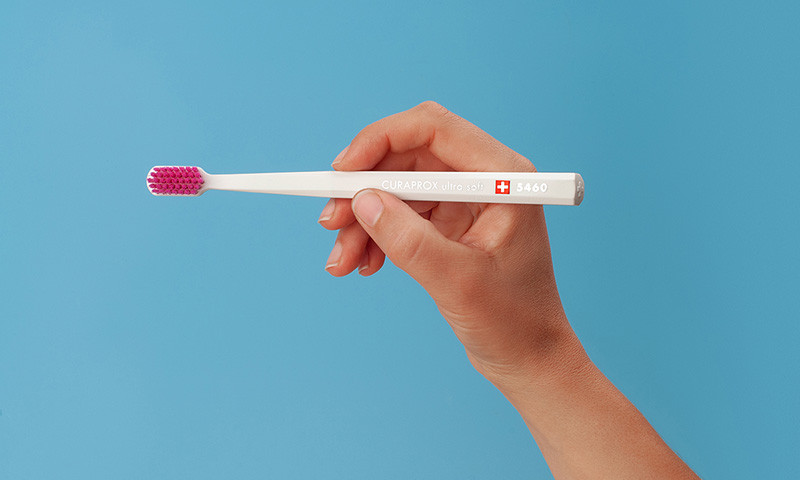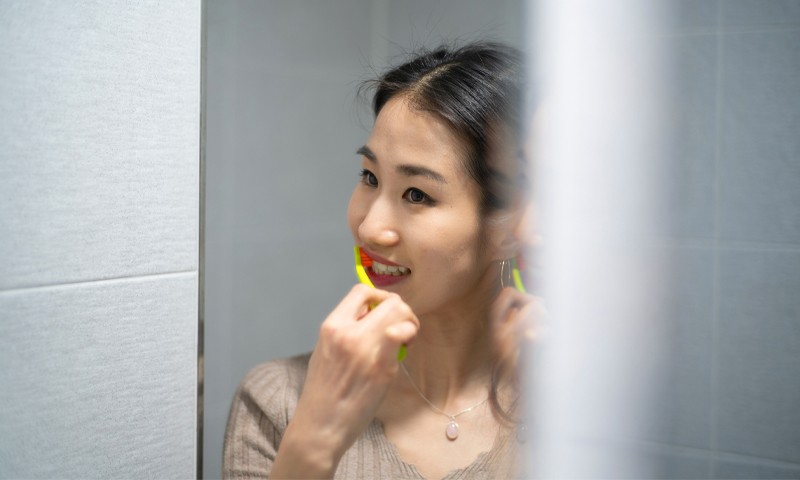Why do you have to brush your teeth?
Besides keeping your teeth clean, regular and correct brushing also keeps them healthy. If you neglect your teeth, it is likely that they will turn an unsightly yellow and that you will experience serious problems in your oral cavity. The two biggest enemies for your teeth and gums are periodontitis and dental caries.
When you brush your teeth correctly, you remove not only food debris – but also plaque. This is a thin film of bacteria and other germs that constantly forms on and between your teeth. If you fail to remove plaque regularly, it hardens into tartar, which is extremely difficult to remove with a toothbrush, even after prolonged and vigorous scrubbing. The problem: Plaque contains millions of bacteria. And the products of metabolism of these bacteria attack your gums.
Periodontitis
If your gums become inflamed, this can have serious consequences: The first sign of periodontitis is often bleeding gums – for example after brushing your teeth or biting into a juicy apple. Next, the gums appear red and swollen. As the disease advances, the inflammation extends deeper into the gums, leading to the development of periodontitis or inflammation of the periodontium. The inflammation causes the gums to shrink and the bone to weaken, which can ultimately result in the loss of teeth.
In the most severe cases, there is a potential risk of the inflammation spreading to your heart and brain, potentially leading to a heart attack or stroke. Since the inflammation can get into your bloodstream through the gum tissues.
Dental caries
Dental caries is also caused by the bacteria in plaque. However, in this case, they do not target the gums but rather attack the enamel. The bacteria in the plaque convert carbohydrates, such as sugar, into acid, which then proceeds to extract minerals from the enamel, gradually softening it. This makes it easy for the bacteria to colonise and swiftly penetrate the interior of the tooth, slowly destroying it from the inside out.
A brief overview of the most important facts: How often, how long and when should you brush your teeth?
Is once a day enough? No! For good oral hygiene, brush your teeth thoroughly at least twice a day – for three minutes each time. The best idea is to clean the spaces between your teeth thoroughly once a day with an interdental brush.
When should you brush your teeth?
If you want to brush your teeth correctly, it is advisable to do it in the morning after breakfast and at night before going to bed. But you can, of course, brush them more often if you like.
However, brushing your teeth in the evening is especially important for good oral hygiene. Pay particular attention to your toothbrushing technique before going to bed and do not forget to clean the spaces between your teeth. Otherwise, the bacteria in the plaque have all night to attack your teeth and gums. Further, saliva production, which helps protect the enamel, decreases during the night, leaving your teeth vulnerable to bacterial attack without adequate defence. Remember to not eat or drink anything after brushing your teeth in the evening – although it is okay to have a glass of water.
Should you brush your teeth before breakfast?
You might have asked yourself when is the right time to perform your morning oral hygiene routine: Should you brush your teeth before or after your first coffee of the day? Our clear recommendation: Brush your teeth after breakfast. The ideal morning routine is: Get up, have a coffee and breakfast, shower, get ready and then brush your teeth.
Should you brush your teeth after eating?
Perhaps you learned as a child: "Do not forget to brush your teeth after eating". But should you brush your teeth straight after eating? Or should you wait a few minutes? Rest assured, you are not alone with these questions that have engaged dental professionals for many years. The fact is: Acidic foods attack the enamel of your teeth. For instance, if you brush your teeth immediately after eating an apple, the acid attack on your enamel makes it even "softer", posing a serious risk of further damage during the brushing process.
This also applies to the following foods:
- Citrus fruit: Lemons, limes, grapefruit, oranges, mandarin oranges and their respective juices
- Very acidic fruit: Apples, peaches, pineapple, pomegranates, plums, grapes, blueberries and tomatoes
- Soft drinks: Coke, lemonades, sweetened ice teas, calorie-free drinks, but also all types of fruit juices
- Sweets: Chocolates, toffees, gummy bears, etc.
Nevertheless, the best idea is to get into the habit of waiting roughly 30 minutes after each meal before brushing your teeth. By adhering to this rule, you will resist the urge to immediately brush your teeth, even after consuming some fruit, juice or coke.
How long should you wait to eat after brushing your teeth?
It is not a good idea to eat straight after brushing your teeth. Firstly, the flavour of the toothpaste will ruin the taste of your food. And secondly, the fluoride and enzymes present in toothpaste will not be able to develop their full effect. It is best to wait 30 or preferably 60 minutes before eating and to relish the refreshing taste in your mouth during this period.
Good to know:
If you additionally want to protect your teeth from acid attack, it is advisable to rinse your mouth with water after consuming highly acidic foods or beverages.
How do you brush your teeth correctly?
You already know: Oral hygiene has to be taken seriously. But how exactly do you brush your teeth correctly? And what do you have to consider? Find everything you need to know about brushing your teeth below.
There are lots of different toothbrushing techniques. However, there are some significant differences in quality. While some toothbrushing techniques fail to remove any plaque at all, others may even lead to your gums receding. If you are eager to learn the correct and most effective toothbrushing technique, we have some good news: There is a clear winner among the various techniques – the modified Bass technique.
The correct technique: Gentle and thorough
A study carried out by University College London found that the most commonly recommended method was the modified Bass technique. Further, researchers from the universities of Seville and Riyadh discovered that this brushing technique removes plaque significantly better than other methods and additionally reduces the risk of gum disease.
Let us take a closer look at this technique and walk you through it step by step. Particularly important here: Be gentle to your teeth! Aggressive scrubbing with a hard toothbrush and excessive force is not only detrimental but also harmful, as it can cause your gums to recede. It is best to use a soft toothbrush.
Moreover, make sure you reach all your teeth – from all sides. Discover how to do this properly in our step-by-step instructions to brushing your teeth correctly.
Step-by-step instructions to brushing your teeth correctly
To ensure you brush your teeth correctly, it is advisable to establish an oral hygiene routine where you never have the chance to skip or overlook any of your teeth or difficult-to-reach areas. Because bacteria love to colonise these areas of your oral cavity. We therefore recommend starting with the difficult and hard-to-reach areas – in other words, the back molars and inner surfaces.
The correct starting position
Before you start brushing, a few basic rules:
- Rinse your mouth thoroughly with warm water to wash away any food debris.
- Use a pea-sized amount of toothpaste.
- Hold the toothbrush loosely like a pen and make sure that half of the filaments are sitting across your gums and the other half over your teeth.
- Tilt the brush to a 45-degree angle to allow the filaments to clean the gum line. The toothbrush is at an upward sloping angle in the upper jaw and a downward sloping angle in the lower jaw.
- When brushing, make sure that half of the filaments are always sitting across your gums and the other half over your teeth.
- Hold the toothbrush in a horizontal position when brushing the outer surfaces. When brushing the inner surface of the incisors and canines, the backside of the back molars and other difficult-to-reach areas, hold the toothbrush in a vertical position.
- Brush your teeth in small, gentle circular movements – with very little pressure.
Good to know:
The Curaprox CS 5460 toothbrush is not only equipped with 5,460 super-soft filaments that clean your teeth gently and thoroughly. Its octagonal handle ensures that you automatically hold the toothbrush at the correct angle.
Important: To avoid washing away the protective effect of the fluoride, just spit out the toothpaste; do not rinse your mouth again with water. This allows the enamel to absorb the fluoride.
You can also watch the video tutorial on how to brush your teeth correctly with our CS 5460 toothbrush. View the steps described above in action.
Brushing children's teeth correctly
Proper brushing is just as important for milk teeth as it is for permanent teeth. In fact, milk teeth are more susceptible to attack. And they can also transmit cavity-causing bacteria to permanent teeth, thus damaging them even before they erupt. If the milk teeth stay free of dental decay, it helps to support and sustain life-long dental health. Discover how and when to teach your child to brush their teeth correctly (and everything else you should know about brushing children's teeth correctly) here:
Good to know:
Did you know that dental caries can be transmitted from one individual to another? If you have dental caries, never place a spoon, dummy or drinking bottle in your mouth before giving it to your child. The cavity-causing bacteria will otherwise be transmitted to your child and make easy work of attacking their soft milk teeth.
The correct toothbrushing tools
You are now aware of the correct technique, but which toothbrush is best to brush your teeth gently and thoroughly? And what type of toothpaste should you be using?
Soft toothbrush
Many people think that the best way to remove plaque build-up is with a hard toothbrush. Wrong. A soft toothbrush is actually three times more effective than a hard one. Why? Because their filaments are much more flexible and therefore reach every contour of the teeth. Further: The more filaments, or bristles, a brush has, the softer it can be. With a hard brush, the space between the individual filaments needs to be bigger. As such, hard brushes are unable to remove plaque effectively from every surface. Thorough brushing is something else entirely.
Moreover, cleaning your gum line with a hard toothbrush is actually quite a painful endeavour. That is why a lot of people neglect brushing this particularly important area of their oral cavity. It is, however, especially important to brush away plaque from this area to prevent bacteria from building up. And this is the reason why we recommend brushing along the sides of your teeth especially where the teeth meet the gums.
If you continue to scrub your gums aggressively with a hard toothbrush despite the pain, it will cause the gum line to recede – which is an irreversible process. This recession exposes the necks of your teeth, causing pain and sensitivity.
Good to know:
With the Curaprox CS 5460 manual toothbrush, the name says it all. It is equipped with exactly 5,460 ultra-soft filaments – roughly ten times more than a conventional toothbrush. Just perfect for brushing your teeth gently and thoroughly. What is also cool is that you can mix and match your favourite colours.
How do you brush teeth with an electric toothbrush?
When it comes to brushing teeth, there are two camps: There are those who swear by a manual toothbrush, and there are those who love using an electric one. But what is actually better, manual or electric? The answer is simple: They are both as good as each other – but only if you use the correct brushing technique.
An electric toothbrush is therefore not absolutely essential, but it can be very helpful – especially for people with limited mobility and children. Sonic toothbrushes utilise saliva, toothpaste and water to create a kind of mini-tornado to remove plaque from the spots that are virtually impossible to reach with the filaments of a brush. This is particularly handy for people with braces, implants and bridges.
Step by step: How to brush your teeth with an electric toothbrush
General rules for use of an electric toothbrush: Do not apply any pressure and use slow movements. Hold the brush vertically to clean the backsides of the molars and the inner surfaces. Otherwise, hold the brush horizontally.
This is the ideal technique for brushing teeth with an electric toothbrush:
- Position the brush head on the side of your teeth, where the teeth meet the gums – without pressure.
- Follow the same pattern as you would with a manual toothbrush: Start with the last molar and brush the inner surface of each tooth along the lower row of teeth thoroughly. Follow the contour of each tooth and move the brush back and forth gently.
- Then brush the outer surfaces followed by the chewing surfaces.
- Now repeat the whole process on the upper row of teeth.
Find everything you need to know about brushing your teeth with an electric toothbrush below:
Instructions: Brushing teeth correctly with an electric toothbrush
Fluoride toothpaste
Unless you live in a region with very high fluoride levels in tap water, it is advisable for your toothpaste to contain fluoride – for school children, teenagers and adults, the recommended fluoride concentration is up to 1,500 ppm; while for younger children, it should be up to 1,000 ppm. Fluoride helps prevent dental caries by hardening the enamel.
When choosing a toothpaste, also make sure that it does not contain any harmful ingredients such as microplastics, SLS and triclosan. SLS (sodium lauryl sulphate) is a chemical compound commonly used as a foaming agent in toothpaste. However, it can dry out the oral mucosa and potentially contribute to the development of oral aphthae. Triclosan is known to disrupt hormone levels and is suspected of promoting the growth of cancer.
Good to know:
Curaprox toothpastes do not contain any harmful ingredients such as microplastics, SLS and triclosan. Instead, Curaprox toothpastes offer a natural and gentle alternative, utilising enzymes that are also found in saliva, thereby effectively cleaning teeth, while also strengthening the enamel and providing protection.
Correct tooth brushing also involves using a toothpaste that does not weaken the enamel of your teeth. Often, whitening toothpastes contain polishing agents and abrasives that gradually wear down the enamel. An easy way to check whether your toothpaste is potentially damaging the enamel of your teeth is to take a look at its level of relative dentin abrasivity (RDA). The higher the value, the more abrasive the toothpaste.
The lowest RDA values are between 20 and 70 and are considered to be ideal. These toothpastes contain only fine particles and clean your teeth in a gentle yet thorough manner. They are, therefore, ideal for people who suffer from highly sensitive teeth.
Average RDA values range between 70 and 100 and are considered safe for healthy teeth – most toothpastes on the market fall into this category.
Above an RDA value of 100, toothpastes are deemed to be highly abrasive and not suitable for daily use. We would strongly advise you to steer clear of these toothpastes.
Good to know:
Curaprox toothpastes of the Enzycal and 'Be you' series boast very low RDA values of between 30 and 60 and are, therefore, particularly gentle on your teeth. This is despite the fact that the 'Be you' toothpastes have a whitening effect. Even 'Black is white' has a relatively low value of 90 for a whitening toothpaste – quite a few toothpastes in this category exceed the 200 mark.
Complete oral hygiene: More than just brushing your teeth correctly
If you think brushing your teeth twice a day, for three minutes each time, is enough, you might be in for a surprise. Proper oral hygiene includes a few additional steps.
Cleaning interdental spaces
Brushing alone only removes two-thirds of the plaque. It is virtually impossible to clean the spaces between your teeth, which bacteria love to colonise and where dental decay, gum disease and periodontal disease usually first take hold. Therefore, correct toothbrushing definitely includes cleaning these interdental spaces. How? It is best done with an interdental brush. When? Once a day – preferably at night before going to bed. It does not matter whether you clean the spaces between your teeth before or after brushing your teeth. And it is so easy to do: In, out, done.
In a meta-analysis, scientists from the University of York found that interdental brushes are more effective when it comes to cleaning the spaces between teeth than dental floss. Further, interdental brushes do not cut into your gums, therefore offering a gentler approach to oral hygiene. There is one exception, however. Some people find that the spaces between their incisors are too small for interdental brushes. In this case, it is perfectly fine to use dental floss.
Do you want to learn more about cleaning interdental spaces? Then take a look at our detailed instructions:
Good to know:
While interdental brushes gently and thoroughly clean the spaces between your teeth, it is quite normal for your gums to experience initial bleeding if you have not regularly cleaned these spaces before. This is an indication of slight inflammation caused by bacteria and the reason why you should definitely continue to use an interdental brush. The bleeding should stop after about a week as the inflammation has subsided.
Cleaning your tongue
Did you know that roughly 60 percent of the bacteria in your oral cavity can be found on the tongue. And that about 90 percent of the bacteria that cause a malodour lurk at the back of the tongue? If you want to banish dental decay and bad breath, you should also regularly remove the coating from your tongue with a tongue scraper. Once a day is sufficient – preferably first thing in the morning.
Discover more information on how to clean your tongue and why it is so important to do so here:
Good to know:
The Curaprox tongue scraper has an anatomically correct shape to avoid gagging – even when cleaning the rearmost part of your tongue.
Mouthwashes only if recommended
Does a proper oral hygiene routine involve using mouthwash? No. There is no need to use a mouthwash if your oral cavity is healthy. In fact, the pleasant sensation of freshness you get from a mouthwash can be quite deceptive. Your mouth might feel super clean and well maintained. But mouthwashes fail to combat plaque properly and additionally disturb the natural balance of your oral flora. If you want to remove plaque, the only thing that really helps is gentle brushing with a toothbrush.
That said, there are a few exceptions: In certain situations, it is imperative to use a medical mouthwash with chlorhexidine – for example, before or after surgical procedures in the oral cavity or if you are suffering from periodontitis. These mouthwashes kill all the bacteria in your mouth – both the 'good' and the 'bad' ones – thus enabling re-establishment of the natural balance after treatment.
Obviously, this also has some disadvantages, too. Chlorhexidine may discolour your teeth and change the way foods taste. Therefore, only use these mouthwashes if your dentist has recommended them.
Good to know:
The oral rinses of the Curaprox Perio plus series contain very little chlorhexidine, as Citrox® – a natural extract from bitter oranges – helps to enhance their antiseptic efficacy. This is also a reason why our mouthwashes stain your teeth less.
Dental care throughout the day: Sugar-free chewing gum against dental decay
To guarantee a pleasant sensation of freshness throughout the day, chew on some dental care chewing gum. It is a great alternative if you are unable to brush your teeth after an office lunch or when you are out and about. Moreover, chewing sugar-free gum helps to stimulate the flow of saliva to wash away bacteria and food debris. Saliva also neutralises the acids that would otherwise attack the enamel of your teeth. But remember to always use a sugar-free chewing gum – preferably with the ingredient xylitol, which can help fight off tooth decay.
Important: Needless to say, chewing gum should never replace brushing your teeth correctly in the morning and last thing at night, as chewing gum basically only cleans the chewing surfaces of your teeth.
Regular check-ups and professional dental cleaning
Even if you follow all the recommendations and brush your teeth correctly every day, you still need regular dental check-ups to keep your teeth healthy. Despite your best efforts, plaque and tartar can still build up in areas that are tricky to reach. Your dental care professional has the proper tools to remove plaque and will also be more than happy to provide you with advice on the best dental and oral health routine.
Furthermore, the German Dental Association recommends patients with a healthy mouth to have their teeth cleaned professionally once or twice a year – although more frequent cleaning is suggested for those with oral diseases.
Please don't: Common mistakes and poor toothbrushing techniques
Although toothbrushing is something we do every day, there are so many mistakes you can make. Besides being less than ideal, some brushing techniques pose a significant risk of damage to your teeth. Below are a few techniques for brushing your teeth that are either bad or have just never caught on for various reasons.
Rapid cleaning
Probably the most common mistake when brushing teeth: A squeeze of toothpaste and a quick scrub of the outer and chewing surfaces, all done in less than 30 seconds. The inner surfaces, the gum line and the interdental spaces remain untouched. These often overlooked areas provide an ideal breeding ground for bacteria to flourish. If not removed by your toothbrush and toothpaste, these germs soon feel right at home in your oral cavity. The consequences: Plaque, tartar, dental caries and periodontitis.
Applying too much pressure
Despite all your good intentions, scrubbing your teeth vigorously and exerting too much pressure may inadvertently damage your teeth and gums. Over-aggressive brushing – especially with a hard toothbrush – is actually very bad for your teeth. The consequence: Gum recession resulting in the neck of a tooth being exposed – causing extreme pain and sensitivity. Besides, you will not reach those tricky spots simply by applying more pressure. If you want to do the job correctly, brush each tooth individually – slowly, thoroughly and gently.
The Fones technique (rotary brushing technique)
In the past, the expert advice was to brush the outer surfaces of your teeth in large circular movements while keeping your teeth clenched together. However, this rotary brushing technique is now considered outdated, as it damages the gums and fails to clean the interdental spaces sufficiently. Nowadays, the technique is only recommended for individuals with mental or physical disabilities, as well as young children who have yet to develop the motor skills required for proper toothbrushing. The modified Bass technique, as described above, is now widely endorsed by experts.
Bass technique (vibratory motion technique)
The original Bass technique, also known as the vibratory motion technique, involves slightly more intricate movements than the modified version you have already read about. It was developed by Charles Cassidy Bass, who is now often referred to as the father of preventative dentistry.
With this technique, you also position the brush head at a 45-degree angle on the side of your teeth – where the teeth meet the gums – but instead of making small circular movements you use quick back-and-forth motions to loosen plaque from your teeth. A problem with using the Bass brushing technique is that there is a very fine line between gentle vibratory strokes and scrubbing, which might damage your gums. Otherwise, the vibratory motion technique is considered an effective method for cleaning your gum line. The Bass technique recommends gentle back-and-forth motions when brushing the chewing surfaces.
Stillman's technique (sweeping or red-white technique)
Stillman's brushing technique (also known as the red-white technique) does not involve scrubbing or circular movements. Instead, short, light sweeping movements from red to white – in other words from gums to teeth –are made to remove the plaque. With this technique, the toothbrush is held at an angle towards the gum (in contrast to the Bass technique) and a slight amount of pressure is applied. Repeat this movement four to five times for each group of teeth. Chewing surfaces are brushed using gentle back-and-forth motions, exactly the same as with the Bass technique. Stillman's technique is recommended for individuals suffering from gum recession and teeth with exposed necks.
Charter's technique
Charter's brushing technique works in exactly the opposite way to Stillman's: But instead of brushing from red to white, you brush from white to red – in other words from teeth to gums. Today, this technique is very rarely recommended and was originally intended to open up, clean and massage the gum line.
Summary: Seven tips for brushing teeth correctly on a daily basis
What is the correct way to brush your teeth? How long should you brush your teeth? When is the best time to brush your teeth? How long should you wait to brush your teeth after eating? Discover everything you need to know below:
- Clean your teeth at least twice a day for three minutes each time: In the morning after breakfast and at night before going to bed.
- Clean your tongue each morning using a tongue scraper and the spaces between your teeth each evening with an interdental brush.
- Use a soft brush and only apply a slight amount of pressure when brushing. Position the brush at a 45-degree angle where the teeth meet the gums, and at an upward sloping angle in the upper jaw and a downward sloping angle in the lower jaw.
- Use the modified Bass technique to brush your teeth: Start brushing the inner surface of each tooth along the lower row from back molar to back molar. When you reach the last molar, switch to the outer surfaces followed by the chewing surfaces. Now repeat the whole process on the upper row of teeth – always making slow and small circular movements.
- To avoid washing away the protective effect of the fluoride, just spit out the toothpaste; do not rinse your mouth again with water.
- Wait 30 minutes to brush your teeth after consuming acidic and sweet foods and beverages. Instead of snacking frequently throughout the day, consciously enjoy a sweet treat once a day.
- Only use a mouthwash if recommended to do so by your dentist.
Sources
Alanazi, Khalid Jamal et al.: Influence of Tooth Brush Grips and Brushing Techniques on Plaque Removal Efficacy, in; Journal of Dentistry and Oral Health. 2017.
Apothekenumschau: Parodontitis.
AOK: Zahnpflege: So bleiben Ihre Zähne schön und gesund.
Hellwege, Klaus-Dieter (ed.): Die Praxis der zahnmedizinischen Prophylaxe. Ein Leitfaden für die Individualprophylaxe für Zahnärzte und Mitarbeiter, Thieme 2018.
Imai, PH et al.: Comparison of interdental brush to dental floss for reduction of clinical parameters of periodontal disease: a systematic review, in: Canadian Journal of Dental Hygiene. 2012.
German National Association of Statutory Health Insurance Physicians (KZBV): Professionelle Zahnreinigung.
Medizinaspekte: Warum gesunde Zähne für den Körper wichtig sind.
NDR: Wie putze ich meine Zähne richtig?.
Austrian Health Insurance Fund (ÖGK): Zähne putzen – aber richtig.
Poyato-Ferrera, Manuel: Comparison of modified Bass technique with normal toothbrushing practices for efficacy in supragingival plaque removal, in: International Journal of Dental Hygiene. 2003.
Wainwright, J.; Sheiham, A.: An analysis of methods of toothbrushing recommended by dental associations, toothpaste and toothbrush companies and in dental texts, in: British Dental Journal. 2014.
Suhasini, Jennifer et al.: Brushing Techniques, in: European Journal of Molecular & Clinical Medicine. 2020.
All websites last accessed on 14 April 2023.
 Swiss premium oral care
Swiss premium oral care















